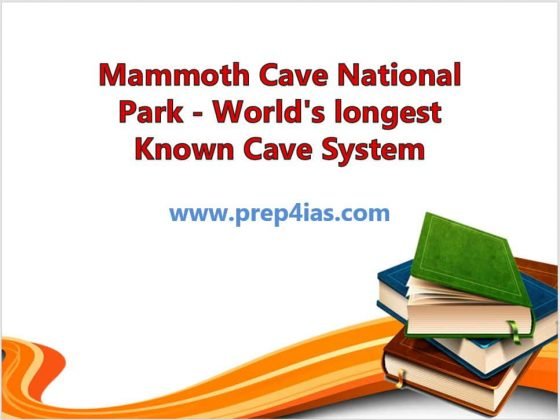Mammoth Cave National Park is a national park located in West-Central Kentucky in United States. It is known for its mammoth size and is currently the longest cave system in the World. The park and its underground network of more than 560 surveyed km of passageways are home to a varied flora and fauna, including a number of endangered species. The Cave is renowned for its extremely vast and large size of horizontal passages and vertical shafts. We will see some more important points about this Mammoth Cave system in below section.

Mammoth Cave National Park - World's longest Known Cave System
Also Read: Zaporizhzhia – Europe’s Largest Nuclear Power Plant is Under Attack
- The official name of the system has been the Mammoth-Flint Ridge Cave System.
- It is the world's longest known cave system with more than 420 miles (680 km) of surveyed passageways.
- It is nearly as twice as long as the second-longest cave system, Mexico's Sac Actun underwater cave.
- It was declared as a World Heritage Site on 27th Oct, 1981.
- Mammoth Cave National Park is managed under the authority of the Organic Act of August 25, 1916 which established the United States National Park Service.
- The Green River runs through the park, with a tributary called the Nolin River feeding into the Green just inside the park.
- The long passages with huge chambers, vertical shafts, stalagmites and stalactites, splendid forms of beautiful gypsum flowers, delicate gypsum needles, rare mirabilite flowers and other natural features of the cave system are all superlative examples of their type.
- The Cave has rich flora and fauna with more than 130 species of wildlife known to exist there.
- The Cave exhibits almost all forms of geological cave processes known.
- It offers world's greatest variety of sulfate minerals.
- The huge and complex network of cave passages provides a clear, complete and accessible record of the world’s geomorphic and climatic changes.
- The park witnessed Earth's evolutionary changes and contains ongoing geological processes and unique wildlife.
- The stunning Karst topography around the cave presents the illustrious history of 100 million years of Cave System.
- From past several years, Mammoth Cave and its karst terrain started facing threats and challenges mostly from the external sources.
- The large portions of the Mammoth Cave watershed lie outside park boundaries, activities conducted in these privately-owned areas greatly influence water quality and quantity within the park.
- Water quality is influenced by sewage and waste disposal, farming and forestry practices, oil/gas wells, railroads and highways.
- Water quantity is influenced by flood-control dams on the Green and Nolin Rivers, and a small lock and dam immediately downstream of the park.
- The integrity of Mammoth Cave has been strengthened as a result of five significant measures that have been taken since Mammoth Cave National Park was inscribed in 1981: an updated General Management Plan in 1983; the establishment of the Mammoth Cave Area International Biosphere Reserve in 1990 and subsequent expansion in 1996, a regional sewage system, installed in the early 1990s, which serves both the park and three adjacent communities; the establishment of the Mammoth Cave International Center for Science and Learning in 2004; and the discovery and mapping of 140 additional miles (225 km) of cave passageways over the past 31 years. More on UNESCO Official website.
- The regional sewer system has greatly increased protection of the park’s sensitive cave system by servicing most of the areas that drain into the Mammoth Cave.
- The 1996 expansion of the Mammoth Cave Area Biosphere Reserve to 367,993 hectares has also played an important role in securing the property’s integrity and maintaining water quality.
- The Biosphere Reserve now includes all or portions of six counties near Mammoth Cave National Park, encompassing the ecologically sensitive hydrological recharge area for Mammoth Cave National Park as well as a large interaction zone.
